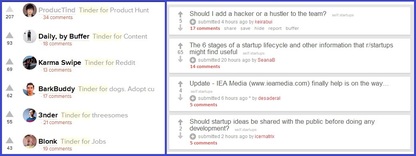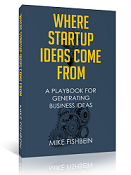Some of the of the most successful companies in history started by "doing what's working." "Do what's working" means supplying something (or a variation of something) that you know (or have some indication) people have demand for.
The riskiest and hardest part of a startup is not building the product, monetizing it, or it's strategy...the biggest reason why early stage startups fail is building something no one wants.
If people are spending their time or money on a given product or service, it is an indication that the product or service provides something that they want. By supplying something that has at least some validated demand, you increase your chances of meeting a market demand. By starting with something with validated market demand, you decrease your customer discovery time and can get to customer validation faster.
"Do what's working" could mean (1) providing a validated solution to the same problem (replicating), (2) supplying a validated solution for one problem to a different problem, or (3) providing a variation of a validated solution to the same problem (differentiating).
The startup ideas behind Product Hunt, The iPad, Uber, Google, Wal-Mart, Facebook, Instagram, and many more of the most successful companies in history "do what's working." That is, they solve a problem by applying a previously validated solution, or supply a slightly differentiated solution to a validated problem. Let me walk you through a few examples...
1. Product Hunt: Same Solution, Different Problem
"Same solution, different problem" means taking a product that some group of customers wants in order to solve some problem, and supplying it to to solve a different problem.
Product Hunt applies the user interface of HackerNews and Reddit, two very successful news aggregation services, to the problem of discovering new products. The problem of discovering new products is currently being solved by media companies like TechCrunch and Engadget. So not only did Product Hunt apply a validated solution to a different problem, the different problem had also been validated.
A couple more examples...
Google - Google's search algorithm, the order by which they display results, came from how scientific research papers are ranked. Research papers are ranked based on how many citations from other papers refer to a paper. Google's rankings are based on how many times a given domain or page has been linked to by other domains and pages. There were several other search engine companies in the market (which provided some validation), they just provided a differentiated solution that turned out to be more valuable than the solutions provided by other search engine companies.
Amazon Kindle Unlimited is "Netflix for books." They took the business model of Netflix (pay for unlimited access to movies) and applied it to books. And Amazon was actually a second mover -- a startup called Oyster had already validated demand for the model.
Uber applies the network/p2p marketplace model to the age old problem of transportation.
2. iPad: Same Problem, Different Solution
Steve Jobs, Founder of Apple, is widely considered one of the best product visionaries of all time. Apple's iPad was one example of many extremely successful products that Jobs helped pioneer. The "do what's working" methodology applies to the product development of the iPad.
Apple's iPad is a variation of two existing products that had validated customer demand. The iPad is a handheld portable computer. It is larger than the iPod and iPhone, but smaller than laptops like the Powerbook. All of these products had validated market demand.
Compared to other potential products, the iPad was a lower risk venture because of the validation that the iPod and Powerbook had achieved. The success of the iPod and Powerbook indicated that there was demand for portable computers, both small and large.
Two more examples...
Other examples of competitive axes which you could compete on are UX/UI, privacy, price, and bundling/unbundling.
DuckDuckGo is search (i.e. Google), but private. They don't capture or share their user's search data.
Instagram is social networking (i.e. Facebook), but just the photos. Instagram unbundled the photo sharing component of Facebook...and was later acquired by Facebook for $1 billion!
Robinhood is stock brokerage (i.e. ETrade), but free.
Is this "stealing"?
Is it "lame" that these products are "derivative ideas?" IMO - absolutely not. By doing some of what's working (has validated demand) the risk of building someone no one wants is drastically reduced. In addition, these products solve problems and deliver value to users. Perhaps that's the most important thing.
Key Takeaways
To generate a new business idea that meets customer demand, you can "do" all or part of "what's working." "All" would mean directly competing with an existing company. "Part" would mean differentiating the product, target market, or business model.
"Doing what's working" mitigates the risk of building something no one wants. If another company is getting traction with a given product or service, it's an indication that people want it.
Building something people want is one of the biggest risk and challenges a startup faces. Competition is probably one of the most overestimated risks a startup faces. In fact, being a "second mover" has a lot of advantages.
You don't need a wildly new or unique business idea in order to build a successful business. As you can see from the above examples, some of the most successful companies in history have had some element of replication.
Free book...
Check out my new book, "Where Startup Ideas Come From: A Playbook for Generating Business Ideas". It includes four metholodies to generate business ideas, based on studying dozens of most successful companies in history. The four methodologies optimize for the biggest risk a startup faces: building something people want.
You can get the book for the the price of a tweet here.



